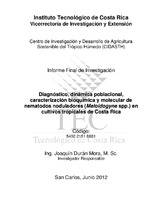Diagnóstico, dinámica poblacional, caracterización bioquímica y molecular de nematodos noduladores (Meloidogyne spp.) en cultivos tropicales de Costa Rica
Resumen
In this paper we conducted a morphological diagnosis and evaluated different primers to use
PCR-RFLPs as method of identification for Meloidogyne species related to tropical crops in the
Huetar Norte, Occidental Valley and Huetar Atlantic regions of Costa Rica. From the primers used, the D2A/D3B and C2F3/1108 provided the largest number of species identified. The PCR product obtained with the D2A/D3B were digested with five different restriction enzymes (AluI, DraI, HinfI, SacI and KpnI) while the PCR products obtained with C2F3/1108 only fragments from 1000 pb or more where digested with HinfI; or 500 pb fragments where digested with DraI.
Electrophenograms were obtained from the digested samples which allowed to differentiate from Meloidogyne species present in the samples. In this way, and using GPS, it was achieved spatially locate identification of the populations by species; being M. incognita the most widely distributed and largest number of hosts, M. javanica and M. arenaria met infrequently and in hot areas, M. hapla was located in cool areas, while M. exigua was found associated to coffee and M. salasi associated with rice.
Identification by molecular methods was more sensitive detection and identified populations at the level of species without the presence of females in the population, in this case the molecular analysis allowed an early diagnosis.
Descripción
Proyecto de Investigación (Código: 5402 2151 8801) Instituto Tecnológico de Costa Rica. Vicerrectoría de Investigación y Extensión (VIE). Escuela de Ingeniería en Agronomía. Centro de Investigación y Desarrollo en Agricultura Sostenible para el Trópico Húmedo (CIDASTH), 2012


